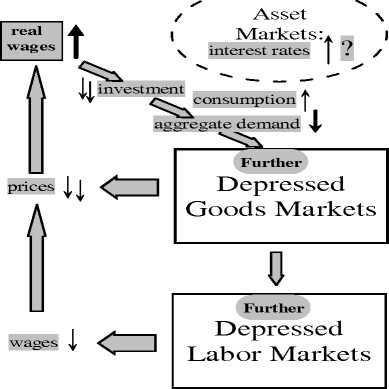This modification and extension of the baseline disequilibrium AS-AD model of Asada,
Chen, Chiarella and Flaschel (2004) in particular goes beyond this earlier approach as
it now also allows for positive effects of real wage changes on aggregate demand, not yet
present in the AD component of our original modification of the conventional AS-AD
dynamics.
The above model - though not microfounded by making the representative household
assumption - is microfounded in the way Keynesian theory was microfounded after
Patinkin and it also makes use of recent approaches, to labor market dynamics as in
Blanchard and Katz (2000). With respect to empirically relevant restructuring of the
theoretical framework it is as pragmatic as for example the approach employed by Rude-
busch and Svensson (1999). By and large we therefore believe that it represents a working
alternative to the New Keynesian approach, in particular when the critique of the latter
approach is taken into account. It overcomes the weaknesses and the logical inconsisten-
cies of the Neoclassical synthesis, stage I, and it does so in a minimal way from a mature
traditional Keynesian perspective (that is not really ’New’). It preserves the problematic
nature of the real rate of interest channel, where the stabilizing Keynes effect (or the in-
terest rate policy of the central bank) is interacting with the destabilizing, expectations
driven Mundell effect. And it preserves the real wage effect of the Neoclassical synthesis,
stage I, where - due to a negative dependence of aggregate demand on the real wage
- we have that price flexibility is destabilizing, while wage flexibility is not. This real
wage channel is not a topic in the New Keynesian approach, due to the specific form of
wage-price dynamics there considered, see for example Woodford (2003, p.225), and it is
summarized in the figure 1 for the situation where investment dominates consumption
with respect to real wage changes. In the opposite case, the situations considered will
be reversed with respect to their stability implications.
Normal Rose Effect (example):
real
wages
Asset
Markets:
interest rates
investment
I ^^ʌænsumption
aggregate demand
prices ∣
Recovery!
Depressed
Goods Markets
wages
-ɔ Recovery!
Depressed
Labor Markets
Adverse Rose Effect (example):

Figure 1: Rose effects: The real wage channel of Keynesian macrodynamics .
The feedback channels just discussed will be the focus of interest in the now following
More intriguing information
1. Palkkaneuvottelut ja työmarkkinat Pohjoismaissa ja Euroopassa2. The name is absent
3. The name is absent
4. The name is absent
5. The name is absent
6. GROWTH, UNEMPLOYMENT AND THE WAGE SETTING PROCESS.
7. Julkinen T&K-rahoitus ja sen vaikutus yrityksiin - Analyysi metalli- ja elektroniikkateollisuudesta
8. Secondary school teachers’ attitudes towards and beliefs about ability grouping
9. Apprenticeships in the UK: from the industrial-relation via market-led and social inclusion models
10. Feeling Good about Giving: The Benefits (and Costs) of Self-Interested Charitable Behavior